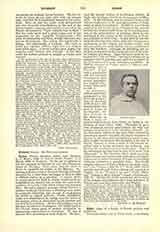

Didot, name of a family of French printers and publishers. FRANCOIS DIDOT, son of Denis Didot, a merchant, HENRI DIDON was b. in Paris, 1689, and d. 1757. In 1713 he opened a bookstore on the Quai des Grands-Augustins, the sign of which was “A la Bible d’or”. The celebrated Abbe de Bernis served for a time there as a clerk, after leaving the seminary. Francois Didot was a learned man, and held by his colleagues in so great esteem that he was elected to the dignity of syndic of the Booksellers’ Corporation in 1735. He received his printer’s charter from the king in 1754. Among the books he published should be mentioned the “Histoire des voyages” (20 vols., quarto), the first seventeen volumes of which are attributed to the Abbe Prevost.
FRANCOIS-AMBROISE DIDOT, b. 1730; d. 1804, succeeded his father Francois, and was appointed printer to the clergy in 1788. All the lovers of fine books highly appreciate the editions known as “D’Artois” (Recueil de romans francais, 64 vols.) and “du Dauphin”, a collection of French classics in 32 vols., edited by order of Louis XVI. He also published a Bible. He invented a new printing-press, improved type-founding, and was the first to print on vellum paper.
PIERRE-FRANCOIS DIDOT, b. 1732; d. 1795, brother of the preceding, founded the paper factory of Essonne and made improvements in type-founding. The most important of his publications are: “L’Imitation de Jesus-Christ” (folio), “Telemaque” (quarto), “Tableau de L’Ernpire Ottoman” (folio). One of his daughters married Bernardin de Saint-Pierre.
HENRI DIDOT, b. 1765, d. 1852, son of Pierre-Francois, made a name as engraver, founder, and engine-maker. When sixty-six years old, he engraved the microscopic type which was used for the editions of the “Maximes” of La Rochefoucauld and Horace’s works. This type was so small that, to cast it, he had to invent a new mould which he called polyamatype (1819), because it founded one hundred letters at a time. He engraved the assignats, the paper money used during the French Revolution.
Saint-LEGER DIDOT, b. 1767; d. 1829, second son of Pierre-Francois, devoted his attention to paper-making in the famous factory of Essonne, and, after ten years of patient experiment, invented a machine to make “endless” paper.
EDOUARD DIDOT, b. 1797; d. 1825, soh of Saint-Leger, made a good translation of Johnson’s “Lives of the Poets”, which was printed by Jules Didot.
PIERRE DIDOT, b. 1760; d. 1853, eldest son of Francois-Ambroise, obtained a gold medal at the exhibition of 1798, for his edition of Virgil. By order of the Government, his presses were established in the Louvre, where they remained during the Consulate. The celebrated Louvre editions are Virgil, Racine, Horace, and La Fontaine. The board of examiners of the 1806 exhibition pronounced the Racine edition “the most perfect typographical production of all ages”. Pierre Didot was also a poet and translated in verse the fourth hook of Georgics, the first books of Horace’s Odes, and also wrote a number of original poems.
JULES DIDOT, b. 1794; d. 1871, son of Pierre, is famous for his invention of round-edged initials, to take the place of the sharp-edged ones. In 1825 he took his printing plant to Brussels and founded the Royal Printing House.
FIRMIN DIDOT, b. 1764; d. 1836, second son of Francois-Ambroise was the inventor of stereotypography, which entirely changed the book trade, and was the first to engrave slips of so-called “English” and round hand-writing. Among the works which issued from his press were “Leg ruines de Pompei”, “Le pantheon egyptien” of Champollion-Figeac, and “Historial du jongleur”, printed in Gothic type, with tail-pieces and vignettes, like the editions of the fifteenth century. In 1827, Firmin Didot gave up business to devote himself to politics and literature. He was a member of the Chamber of Deputies and wrote tragedies (“La Rene de Portugal“, “La Mort d’Annibal”) and essays on literary topics.
AMBROISE-FIRMIN DIDOT, eldest son of Firmin, b. 1790; d. 1876, followed first a diplomatic career and was for a time attache of the French Embassy at Constantinople. He took advantage of his position to visit the East and Greece, being the first to discover the location of Pergamacum. When his father retired in 1827, he, together with his brother Hyacinthe, took the management of the publishing business. They published “Bibliotheque des auteurs Grecs”, “Bibliotheque des auteurs Latins”, and “Bibliotheque des auteurs francais”, an immense collection of two hundred and fifty volumes. Their greatest work was a new edition of the “Thesaurus Graecae Linguae”, of Henry Stephens, edited by Boissonade, Dindorf, and Hose (9 vols., 1855-59).
LOUIS N. DELAMARRE

